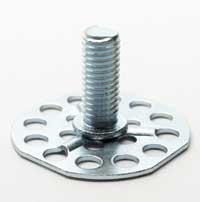
Posted to News on 24th Jun 2013, 00:00
The false economy of the 'cheap' copy
Cheap copies of products, usually from Asia, can end up causing all sorts of problems for users. Here we look at two examples of copy fastening products in the automotive and construction industries

>A well known EU Tier 1 suppler to an automotive OEM, also in Europe, recently thought it could save money by sourcing a cheap copy of a BigHead fastener from Taiwan. No surprise, though, that after or year or so, it turned out to have been a false economy. Perhaps the company had focused too much on the unit price and not enough on the quality systems, engineering know-how and expertise of the supplier, not to mention the customer service impact if problems surface?
>Apart from the high costs of reclamations and repairs, the disruption to the production process and the customer inconvenience, there is of course the costly damage done to the reputation of the Tier 1 supplier. Also, did the OEM know that the Tier 1 was not using a genuine bigHead part but a cheap copy, and had they sanctioned this change? Had proper supplier audits been carried out?
>On detailed inspection of the copy BigHead in question it was possible to discern poorer quality in a number of areas such as 'punch exit burring' to the many head perforations and reduced weld projection form and height, both critical features of the bigHead product design. These resulted in poorer 'flow' of the composite materials around the perforated head, but not so poor that the product failure could be established at this stage. However, a much more serious problem did repeatedly surface when the product was embedded into the Tier 1 supplier's product and was put into service; it frequently broke.
>Like other original designers and manufacturers, British manufacturer BigHead sometimes comes across examples of cheap copies of its automotive, marine, construction, panel, composite and special fasteners. Original BigHead fasteners all share the same basic design, where a flat perforated head which locks the product securely into position and spreads the load is welded to a wide choice of studs, nuts, collars, ins and other fixings to offer versatility.
>It is not possible to tell by looking at the weld on a copy product that it is inferior, but you can certainly tell once you put under load because it breaks. This is why very close control of the manufacturing process of the BigHead fastener is so critical and is why much of the know-how and experience at BigHead has focused on the weld process, enabling the company to achieve a 0ppm defect rate on the weld in 2012. The previous three years having averaged 1.3ppm.
>In another recent example in the construction sector a number of cheap 'knock-off' BigHead copies surfaced at the final purchasing phase, long after the original BigHead had been tested and approved. Despite having worked with the contractors and the architect for over a year, the purchasing function entertained offers from many companies who thought they could make a BigHead. While many seemed capable of copying the bigHead design, at least at first glance, the purchasing function was clearly entering into significant risk and potentially sky high costs in order to secure 'the best price'.
>Without thorough analysis of the manufacturing process and quality control it would be impossible to have any confidence in the integrity of the BigHead copies. Perhaps the appearance of such an appalling copy as already described encouraged the purchasing function to recognise the false and possibly dangerous economy they were considering.
Unit 1, Black Moor Business Park
36A Black Moor Road
BH31 6BB
UNITED KINGDOM
01202 574601









